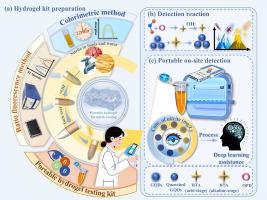Machine learning-assisted dual-mode hydrogel sensor for the detection of nitrite
IF 13.2
1区 工程技术
Q1 ENGINEERING, CHEMICAL
引用次数: 0
Abstract
Accurate on-site detection of nitrite (NO2−) is essential for ensuring food safety and human health. In this study, we developed a portable dual-mode hydrogel sensor combining ratiometric fluorescence and colorimetric detection for accurate nitrite monitoring in food samples. The sensor was fabricated by embedding graphene quantum dots (GQDs) into an agarose hydrogel matrix. Blue-emissive GQDs (λ = 450 nm) functioned as a ratiometric reference and were effectively quenched by orange-emissive benzotriazole (BTA, λ = 578 nm), which forms via a diazo coupling reaction between nitrite and o-phenylenediamine (OPD). This reaction enabled a nitrite-dependent ratiometric fluorescence response, accompanied by a yellow color intensification resulting from the formed BTA. For field applications, a portable hydrogel kit was constructed and integrated with a back-propagation artificial neural network (BPANN) to facilitate the interpretation of nitrite-induced signal changes. The sensor demonstrated high sensitivity, with detection limits of 2.1 × 10−3 mg/L in fluorescence mode, 0.088 mg/L in colorimetric mode, and 0.07 mg/L in the hydrogel-based system. This portable platform enables rapid (<15 min), AI-assisted analysis with cross-platform compatibility, offering a promising tool for food and environmental safety monitoring.

用于亚硝酸盐检测的机器学习辅助双模水凝胶传感器
准确的亚硝酸盐(NO2−)现场检测对于确保食品安全和人体健康至关重要。在本研究中,我们开发了一种结合比率荧光和比色检测的便携式双模水凝胶传感器,用于食品样品中亚硝酸盐的精确监测。该传感器是通过将石墨烯量子点(GQDs)嵌入琼脂糖水凝胶基质中制备的。蓝色发光GQDs (λ = 450 nm)作为比例参考,被橙色发光苯并三唑(BTA, λ = 578 nm)有效猝灭,这是由亚硝酸盐和邻苯二胺(OPD)之间的重氮偶联反应形成的。该反应使亚硝酸盐依赖的比例荧光响应,并伴随形成的BTA引起的黄色增强。对于现场应用,构建了便携式水凝胶试剂盒,并将其与反向传播人工神经网络(BPANN)集成,以促进亚硝酸盐引起的信号变化的解释。该传感器灵敏度高,荧光模式检测限为2.1 × 10−3 mg/L,比色模式检测限为0.088 mg/L,水凝胶体系检测限为0.07 mg/L。该便携式平台可实现快速(<15 min),具有跨平台兼容性的人工智能辅助分析,为食品和环境安全监测提供了一个有前途的工具。
本文章由计算机程序翻译,如有差异,请以英文原文为准。
求助全文
约1分钟内获得全文
求助全文
来源期刊

Chemical Engineering Journal
工程技术-工程:化工
CiteScore
21.70
自引率
9.30%
发文量
6781
审稿时长
2.4 months
期刊介绍:
The Chemical Engineering Journal is an international research journal that invites contributions of original and novel fundamental research. It aims to provide an international platform for presenting original fundamental research, interpretative reviews, and discussions on new developments in chemical engineering. The journal welcomes papers that describe novel theory and its practical application, as well as those that demonstrate the transfer of techniques from other disciplines. It also welcomes reports on carefully conducted experimental work that is soundly interpreted. The main focus of the journal is on original and rigorous research results that have broad significance. The Catalysis section within the Chemical Engineering Journal focuses specifically on Experimental and Theoretical studies in the fields of heterogeneous catalysis, molecular catalysis, and biocatalysis. These studies have industrial impact on various sectors such as chemicals, energy, materials, foods, healthcare, and environmental protection.
 求助内容:
求助内容: 应助结果提醒方式:
应助结果提醒方式:


